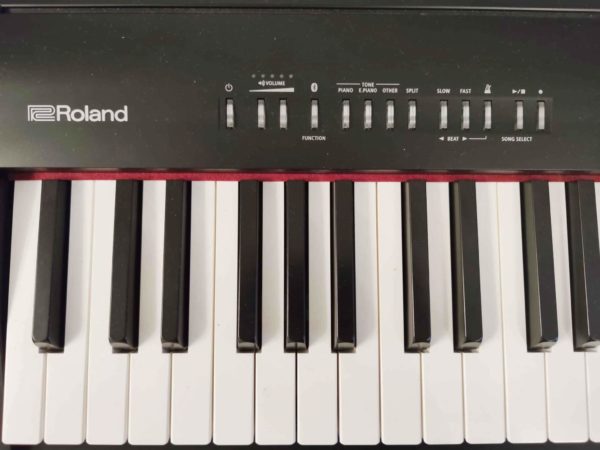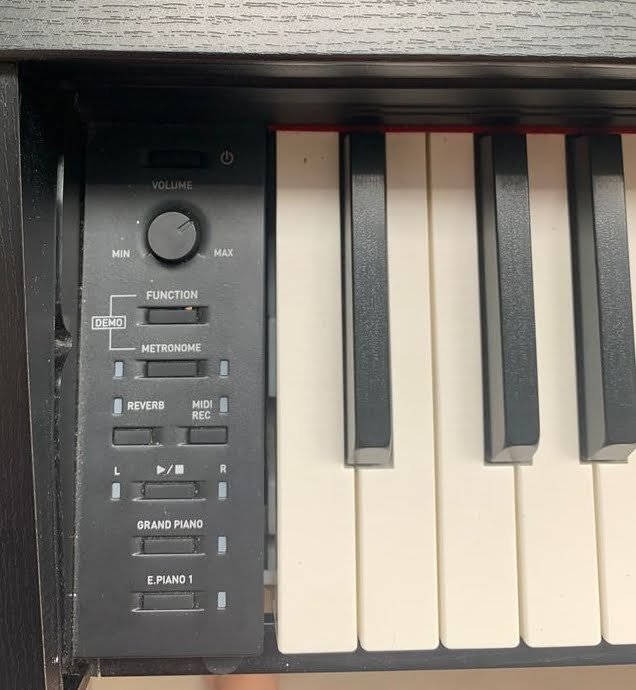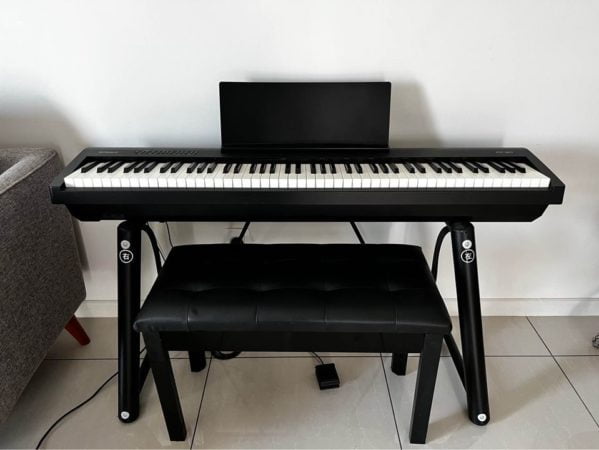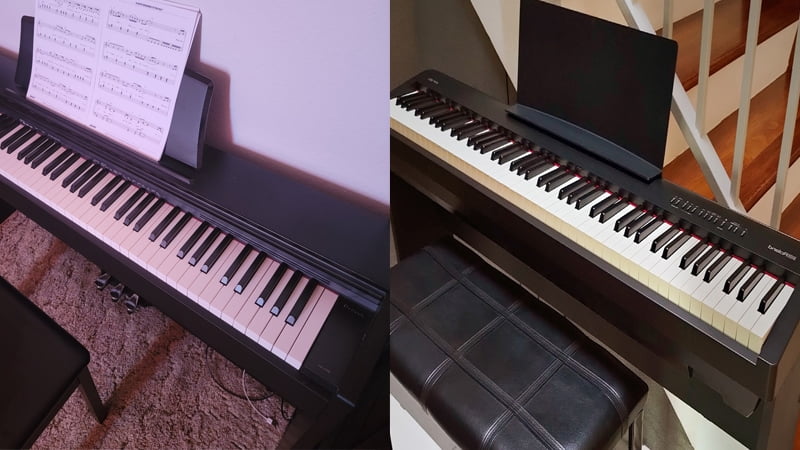In this Casio PX-770 vs Roland FP-30 review, learn why the portable FP-30 is a better investment than the console option.
At first glance, it’s easy to assume that a console digital piano is a better instrument than a portable digital piano. But in the case of this Casio PX-770 vs Roland FP-30 review, the portable option actually won out.
The Roland FP-30 is a workhorse despite being a smaller and lighter option. It comes from a reliable brand, is easily portable, and also features a wide sound library that easily beats out the Casio PX-770.
With that said, if you’re looking for a piano for your home, the PX-770 is still a great option.
Console digital pianos are ideal for performance venues and houses. So, if you need a new church piano or a new instrument to put in your living room, the Casio PX-770 offers the same feel as an acoustic piano at a much more affordable price.
Casio PX-770 vs Roland FP-30: Comparison Chart




Last update on 2025-04-23 / Affiliate links / Images from Amazon Product Advertising API
Casio PX-770 vs Roland FP-30: A Head to Head Comparison
I decided to compare each of the features of both pianos up against each other to find the winner. And to my surprise, the final score was 3-2 in favor of the Roland FP-30.
The Casio PX-770 held its own in almost every category, only trailing behind the FP-30 by a little bit. However, in the end, because of the wider sound library and better overall tone, the Roland FP-30 eventually won out.
Tone
The winner: Roland FP-30
The tone of a digital piano is arguably the most important feature to consider when choosing between the different options. And in terms of tone, it was pretty hard to declare a winner, largely because the Casio PX-770 and the Roland FP-30 offered rich and bright tones that were really close to an acoustic piano.
But since the FP-30 has more built-in voices than the Casio PX-770, it was the winner at the end of it all.
+Tone Generator
One of my favorite features of the PX-770 was the AiR Sound Source. While it uses samples to produce tones just like the FP-30, it also has a built-in AI technology to create a more realistic sound. It does this by modifying the way the sound waves travel through the air, so the voices hit you in the same way as an acoustic piano.
While it’s pretty hard to beat out the PX-770, the Roland FP-30 did a pretty good job as well. The Roland model features the SuperNatural piano sound.
Granted, I didn’t find it to be as realistic as the PX-770. However, for a portable digital piano, it did a surprisingly good job.
And after a close comparison, the difference was very minimal so I couldn’t choose a winner based on tone quality alone.

+Sound Library
Since both pianos had pretty decent tones, the Roland FP-30 features a better sound library. The Casio PX-770 comes with 19 different voices. And for a console digital piano, this is a fair amount of voices.
With the PX-770, you get a wide variety of voices such as electric and acoustic pianos, strings, synths, and even some bass and organ tones. However, when compared to the FP-30, it was easy to see the more versatile option.
The Roland FP-30 features over 35 different tones. So, with this instrument you can choose between a wide variety of different voices, including more experimental voices such as drums and SFX.
So, with the Roland FP-30 you aren’t bound by traditional voices and you can explore different areas of music.
However, if you’re a beginner, it might be better to opt for the limited voices on the Casio PX-770. Since it has less voices, teachers recommend it for beginners so that they can really focus on the basics before branching out to other areas.
Feel
The winner: Tie
It was a joy to play either of these pianos. They are both fully-weighted pianos with textured keys, so it was hard to tell the difference between these options and an acoustic piano. With that said, the Casio PX-770 may offer a more realistic feel due to its console design, but this largely depends on the player’s preference.
So, in the end, I declared it a tie between these two options when it came down to feel.
+Hammer Action
The Roland FP-30 features the PHA-4 hammer action system. While this isn’t the most sophisticated system in the Roland arsenal, it is good enough to offer a realistic feel. With this piano, the keys are heavier on the left side than the right side, so it more accurately emulates the feel of an acoustic piano.
With that said, the Casio PX-770 offers the same type of hammer action. While it doesn’t use the exact tame system, the feel is similar with heavier keys on the left and lighter keys on the right.
And since the Casio PX-770 is a console digital piano, it does offer a slightly more realistic feel, since it comes with a furniture stand. But since both pianos feature a very similar hammer action, I still declared it a tie at the end of the comparison.
+Key Texture
To my surprise, both of these pianos offered textured piano keys. While they aren’t made of wood like some of the more premium options out there, they do offer a more realistic feel than plain old plastic keys.
The Casio PX-770 and the Roland FP-30 have some sort of coating on the keys. These are meant to remove the glossy texture of the plastic and replace it with something closer to ebony and ivory.
While neither of the pianos perfectly match the feel of ebony and ivory keys, they are still far better than other options on the market that don’t have a coating on them at all.
Piano Features

The winner: Tie
This was another area where I found that these two pianos offered the same relative functions. While the Roland FP-30 featured a wider variety of playing modes (which is expected from a portable digital piano), the Casio PX-770 did come with a wider set of effects, so it was a pretty fair give and take.
+Playing Modes
The Roland FP-30 features split, dual, and duo mode (also called lesson mode). These are the three most useful extra piano modes you can have on a piano as they offer a lot of versatility. With split mode, you can divide the piano into two zones with two different voices. This gives you the ability to seemingly “play” two instruments at the same time.
With dual mode, you can blend two different voices together to create a unique and fuller sound. And lastly, you also have duo mode which divides the piano into two mini keyboards with the same timbre and pitch.
Dual mode is also available with the Casio PX-770, but it is referred to as lesson mode.
Another feature on both pianos is a recording function, where the PX-770 holds an edge. While neither of these pianos offer studio-quality recording, the PX-770 offers 2-track recording. The Roland FP-30 only offers 1-track recording, which is expected since it’s a portable piano, but it’s still worth mentioning.
+Effects
In terms of effects, the Casio PX-770 was actually the more versatile model. Since it has chorus, reverb, and brilliance effects, you have complete control over your piano’s tone. You can add a lot of depth and dimension with these different effects, which is what makes it ideal for advanced pianists who are particular about their tone.
On the flip side, the Roland FP-30 only features ambience and brilliance control. Granted, this does offer a fair amount of control over your tone since ambience has a similar function to reverb. However, since it lacks a set of chorus effects, you don’t have as much control over your tone as compared to the Casio PX-770.
Casio PX-770 vs Roland FP-30: The Similarities

These are two very different pianos. The Casio PX-770 is a console piano designed to stay in one place while the Roland FP-30 is easily portable. With that said, they do share a fair amount of similarities.
For example, we mentioned earlier that they share a similar hammer action system. While they have different names, both systems work in relatively the same way to achieve the same results. So, with either of these pianos, you’re assured of a good feel that is very close to an acoustic piano.
Additionally, these two pianos share the same type of speaker system, which is actually a slight surprise since the Casio PX-770 is a console digital piano. So, you can expect around the same maximum volume and tone quality with these pianos.
At the end, I declared the Roland FP-30 the winner because of its versatility, but for the right person, the Casio PX-770 could actually be the better option depending on your own needs and preferences.
Quick Rundown of the Casio PX-770
- 88 scaled, weighted hammer-action keys with simulated ebony and ivory textures
- Stunning new piano sound with detailed resonance, plus 18 other Tones
- Stereo speaker system built into stylish, modern wooden cabinet
- Versatile practice, performance, and MIDI recording tools
- 3 year manufacturer extended warranty
Last update on 2025-04-23 / Affiliate links / Images from Amazon Product Advertising API
Quick Rundown of the Roland FP-30
- Rich, responsive tone from Roland renowned supernatural piano sound engine
- 88-Note Phat-4 standard keyboard provides authentic piano touch for maximum expression
- Powerful amplifier and stereo speakers deliver impressive sound
- Headphones output and quiet keyboard action allow you to enjoy playing at any time without disturbing others
- Optional matching stand and three-pedal unit provide a classic piano look and Enhanced functionality, including hands-free page turning with some sheet music apps
Last update on 2025-04-23 / Affiliate links / Images from Amazon Product Advertising API
Product Videos
Related Articles to Casio Px 770
- Casio PX-770 vs Korg B2SP: A Battle of Budget Console Digital Pianos?
- Casio PX-770 vs Kawai KDP-110: The Best Console Digital Pianos on a Budget?
- Casio PX-770 vs Kawai ES-110: Should You Get A Portable or Console Digital Piano?
- Casio PX-770 vs PX-160: Should You Get A Portable or Console Digital Piano?
- Casio PX-770 vs S1000: Should You Get A Portable or Console Digital Piano?
- Casio PX-770 vs 750: Finding the Best Budget Digital Piano
- Casio PX-770 vs PX-860: Should You Get A Portable or Console Digital Piano?
- Casio PX-770 Vs AP-270: Which Casio Model Wins Out?
- Casio PX-770 Vs 760: Which Is The Better Casio Privia Model?
- Casio PX-770 Vs Yamaha DGX-660: Should You Get A Portable Or Console Digital Piano?
- Casio PX-770 Vs Yamaha YDP-143: Which Is The Better Piano For The Money?
- Casio PX-770 vs Yamaha YDP-144: Which Is The Better Digital Piano?
- Casio PX-770 Vs 780: What’s The Difference Between These Two Digital Pianos?
- Casio PX-770 Vs 870: Which Casio Console Digital Piano Is Better?
- Yamaha P45 vs Casio PX 770: Should You Get the Portable or Console Digital Piano?
- Yamaha P125 vs Casio PX-770 Review: Why the Yamaha P125 Beats Out the Casio Console Digital Piano
Reference
- Casio PX-770: https://www.sweetwater.com/store/detail/PX770BK–casio-privia-px-770-black-finish
- Roland FP-30: https://www.roland.com/global/products/fp-30/specifications/
Lulacruza is an electronic folk duo operating at the junction of the hypermodern and the ancient. Our music weaves together hypnotic female singing, South American folk instruments and electronic processing, while channeling pulsating waves from the source of creation.
Lalucruza is also a community where you can connect with other music lovers to collaborate, exchange ideas and share knowledge. A platform for who wants to learns the basics of playing piano, guitar, drum masters’ technique, etc.. is the premise of our website.
